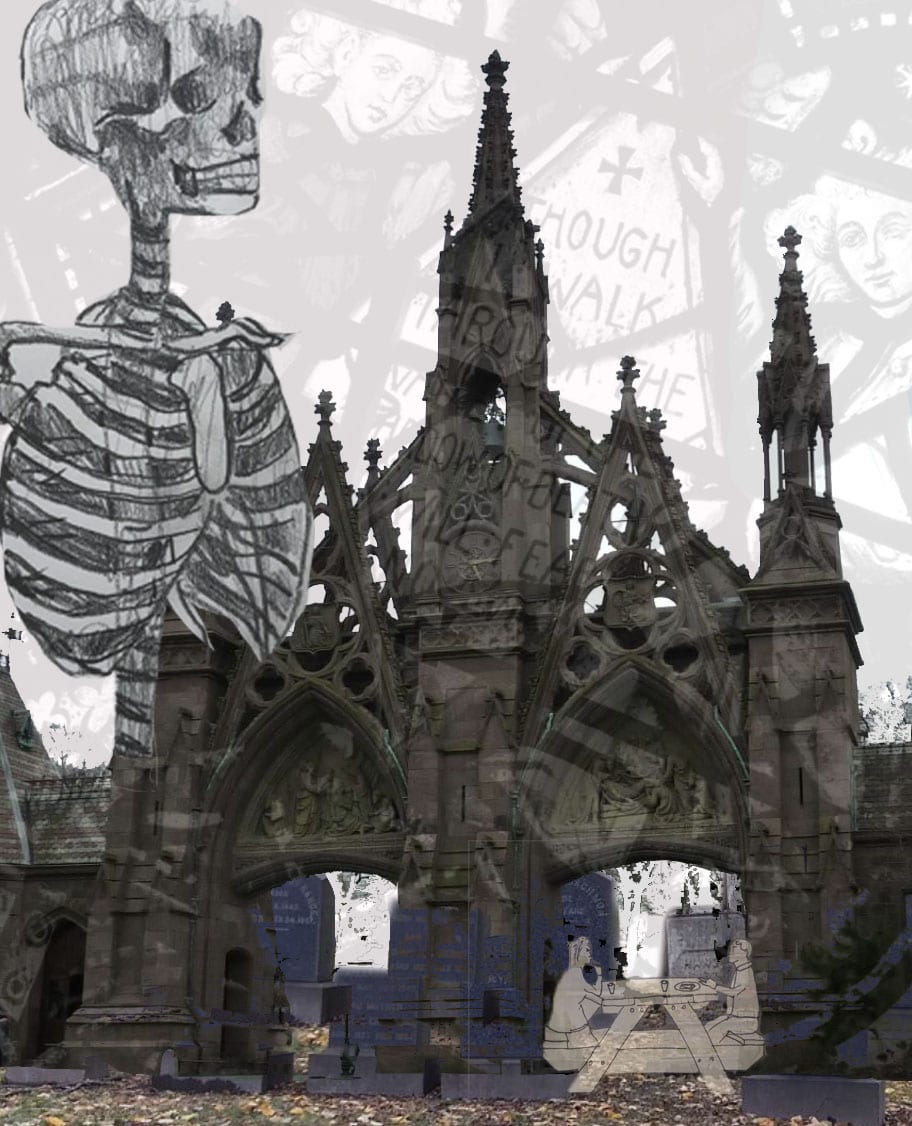The project ‘Peopled Places’ was based on the history, cultural, political and architectural significance of public places – New York City is the perfect place to find public places with unexpected histories.
The first requirement for the project was to do on-site research, then learn and write about the history of the place and lastly create a photoshop collage from sketches, photographs and add hand-drawn detail.
Green-Wood Cemetery
According to the Green-Wood Historic Fund, the cemetery was founded in 1838. By the 1860s, more than 500,000 people a year visited the cemetery. The only destination that was more popular at the tie was Niagara Falls. Green-Wood’s popularity motivated the creation of other New York City public parks such as New York’s Central Park and Brooklyn’s Prospect Park. The cemetery covers 478 acres, where there are glacial ponds, paths, and hills. Over half a million people are buried in Green-Wood Cemetery, including Civil War generals, baseball legends, politicians, inventors, and famous artists, and entertainers. In addition to this, the cemetery is a Revolutionary War historic site. In 2006, the United States Department of the Interior recognized its significance and declared the cemetery a National Historic Landmark (Green-Wood).
Green-Wood Cemetery is a topic of fascination to many, including architecture critic Paul Goldberger, who quotes from a Times article of 1866: “It is the ambition of the New Yorker to live upon the Fifth Avenue, to take his airings in the Park, and to sleep with his fathers in Green‐Wood” (Goldberger). In his article, Goldberger references the history of Green-Wood in many contexts, one being how the cemetery was created. “It was a combination of the need for more burial space and a growing esthetic impulse that led to the movement to bury the dead in rural sites. Green‐Wood’s initiator was Henry Pierrepont, scion of an old Brooklyn family. In 1839 he hired David Bates Douglass, architect of High Bridge – the aqueduct across the Harlem River, to lay out the original 200 acres of the cemetery.” (Goldberger), The reasoning behind the creation of Green-Wood was to find a place both the living and dead could coexist, hence the beauty and design that went into making this cemetery a comfortable “park-like” setting that the living could enjoy. Another aspect of Green-Wood that is discussed in this article is its design, and the many architectural styles found there. Goldberger describes the cemetery as “an almost magical kingdom of Greek temples, Renaissance palaces, Egyptian temples, Corinthian columns, obelisks, and Gothic towers.”
After visiting Green-Wood Cemetery, I felt the presence of various architectural forms representing the different backgrounds of the souls that lay in the cemetery. The gates intrigued me with their size, detail, and beauty. The cemetery is beautiful however there is still an overwhelming sense of death. I was further intrigued by the contrast of the parrots in the gates that have made their nests which give life and vibrancy to the cemetery.
Works Cited
“Green-Wood About /History.” Green-Wood, Green-Wood Historic Fund, 2018, https://www.green-wood.com/about-history/. Accessed 12 Mar. 2018.
Goldberger, Paul. Design Notebook.” New York Times, 17 Nov. 1977, www.nytimes.com/1977/11/17/archives/design-notebook-pastoral-greenwood-cemetery-is-a-lesson-in.html. Accessed 12 Mar. 2019.
On Site Research and Images

Sketch of Gates On Site
COLLAGE
The gates intrigued me and I found them central to Greenwood’s history – regardless of all the added graves, the gates have remained. The overwhelming sense of death is represented symbolically by the skeleton overlooking the gates. The cemetery was built to ensure the ‘living’ and dead coexist hence to represent the historical aspect of how individuals would have picnics at this cemetery I added the hand-drawn element of the picnic table. The layer translucent and looming above the gate and the whole piece is the stained glass window from the chapel, and lastly, the graves are present in the foreground of the picture towards the opening of the gates and bottom of the piece.






